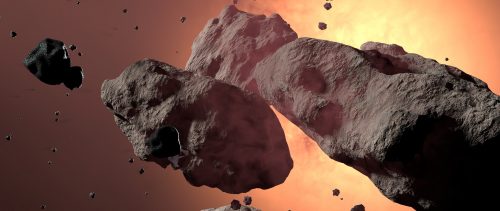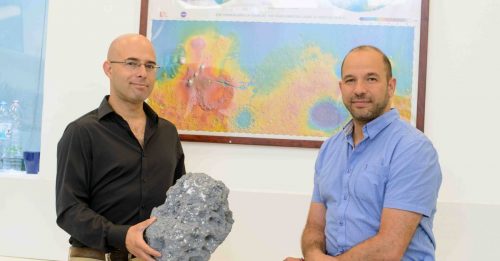The Trojan asteroids of Mars, which move in its circumpolar orbit around the Sun, are different from those found in the asteroid belt between Mars and Jupiter. Scientists from the Weizmann Institute and the Nice Observatory in France offer a new and unique source for these asteroids - and demonstrate how, with high probability, they were formed as a result of a giant collision on Mars.

There are many asteroids in the solar system, mainly in the area called the asteroid belt. It is commonly believed that these bodies are remnants of the formation of the solar system, which failed to unite into a planet. The general assumption is that the Trojan asteroids of Mars were rocks from the asteroid belt that migrated to certain places in the orbit of Mars, known as Lagrange points - unusual positions that lock the bodies in the orbit of the planet.
In order to investigate the origin of seven asteroids at one of the Lagrange points, Dr. David Polischuk, a postdoctoral researcher in the research group of Prof. Oded Aharonson from the Department of Earth and Planetary Sciences, and Dr. Seth Jacobson from the Nice Observatory, on the SpeX instrument on the IRTF telescope in Hawaii. This instrumentation allowed them to study the composition of the asteroids based on their absorption/emission spectra. "The observations showed that all these asteroids are rich in the mineral olivine, which indicates a connection between them. They represent a family with one common origin," says Polishuk.
Olivine-rich asteroids are rare in the asteroid belt; This mineral is often formed deep in the mantle of large planetary bodies, such as Earth or Mars, in areas where high pressure prevails.
"We were able for the first time to make a connection between asteroids and a planetary formation source"

To explain this finding, Polischuk and his colleagues proposed an alternative to the origin of the Trojan asteroids, according to which they were not formed with the other bodies of the asteroid belt as was commonly thought, but originated deep inside Mars - from there they were thrown out into their special orbit at the Lagrange point as a result of a massive collision. the study Recently published in the scientific journal Nature Astronomy.
In order to test this hypothesis, the scientists developed a computer simulation that demonstrates how such a collision could have produced the asteroids, and how they could have been trapped in the Lagrange point they encountered along the orbit of Mars. "In this way, for the first time, we were able to make a connection between asteroids and the source of planetary formation," says Polishuk. "Now that we know that such bodies exist, the next step is to investigate their prevalence and study their characteristic properties."
These findings have implications beyond the question of the origin of asteroids. Aaronson explains: "Since olivine comes from the mantle of the planet - the material from which these asteroids are composed is a unique opportunity to study the internal composition of Mars."
See more on the subject on the science website:

2 תגובות
The story of the collision with Mars is what is scary about this story.
According to an article I read some time ago (sorry, I don't remember exactly where), so somewhere many years ago, Mars was more like Earth, water flowed over it, it had an atmosphere and maybe it had a magnetic field... until a huge body collided with Mars, throwing parts of it into space, Made it turn 90 degrees so today's poles were once its equator...
Some of its fragments are in rotation around it, and another part was blown into space and even reached the earth and are probably still moving around in space and occasionally falling on the earth, I also remember that one of these was found a few years ago in the ice of one of the poles (I don't remember where they found it but because it was There was a stone found in the ice, they realized it was from space and the composition was the same as Martian rocks.
Every mathematician or physicist knows what Lagrange points are. To all other readers:
https://he.wikipedia.org/wiki/%D7%A0%D7%A7%D7%95%D7%93%D7%AA_%D7%9C%D7%92%D7%A8%D7%90%D7%A0%D7%96%27
And if so, then maybe it is possible to write which points for Grange are in question? According to what is written about "in the orbit of Mars" I am guessing that these are nectodes 4-5. (See the drawing in the link).